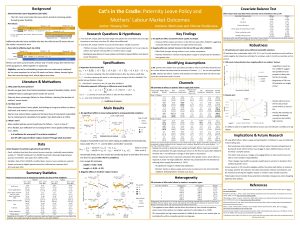
How effective are paternity leave policies in improving new mothers’ labour market outcomes and promoting gender equality? The persistent gender earnings gap largely arises from women’s prolonged career interruptions due to disproportionate childcare responsibilities. Paternity leave policies are designed to mitigate these interruptions by encouraging a more equal share of childcare duties within a household. Existing research primarily examines restrictive, quota-based paternity leave policies, finding increased paternal leave uptake but mixed long-term effects on mothers’ labour market outcomes and household division of labour.
This study analyzes the effect of the UK’s Shared Parental Leave Regulations (SPL), which allows parents to flexibly share leave and pay. Despite having little influence on paternity leave uptake rate and duration, the reform results in a significant positive effect on women’s labour income in the childbirth year. However, this positive effect reverses in subsequent years, leading to negative impacts on mothers’ earnings. Further analysis indicates that SPL may result in a short-term reduction in fathers’ labour supply, possibly reflecting some increased childcare involvement that initially supports mothers’ earnings. Yet, this shift is accompanied by a decline in fathers’ life satisfaction and followed by a reduction in mothers’ labour supply. These patterns are consistent with research suggesting that short-term deviations from traditional gender norms may backfire on progresses in gender equality.
